Armored cars of the FIAT-Ansaldo Autoblinda family (Italy)
The Italian leadership had big plans to colonize Africa. This required a variety of equipment, including armored cars, which were to serve in the colonial police. In addition, the army needed the equipment, the existing machines of which already had a solid age and could not effectively solve the tasks assigned to them. In 1938, Ansaldo received an order for the development and construction of a promising armored car that could be used in various units with different characteristics of combat work.
Having analyzed the customer’s requirements, the specialists of the development company decided to make one armored car for both the army and the colonial police. Due to some technical solutions it was supposed to ensure maximum efficiency of application, regardless of specific tasks. The new project received a simple and logical name - Autoblindo (“Armored Car”) or abbreviated AB. Further, in order to distinguish between modifications, numbers were added to the two letters of the name.
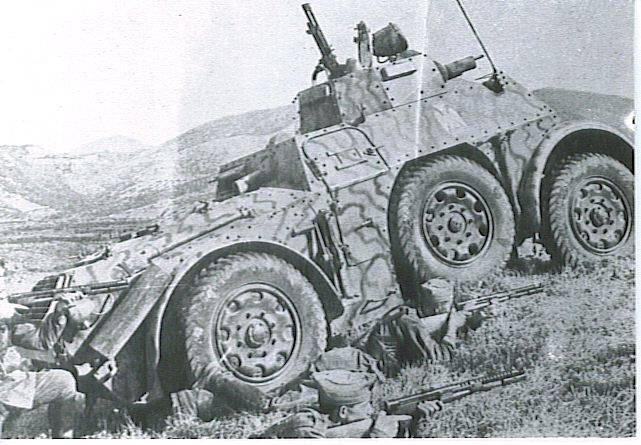
The armored car AB.40 accompanies the infantry. Photo by Warwheels.net
To simplify the production of new armored vehicles, it was decided to use a ready-made chassis. Previous Italian-made armored cars had specific characteristics of mobility and maneuverability, which is why the authors of the AB project had to pay particular attention to finding the right chassis. In the end, as the base for the new armored car, the chassis of the artillery tractor FIAT-SPA TM40 was chosen, which shortly before it was put to the test. Thanks to this, the advanced armored car chassis got its full name: FIAT-Ansaldo Autoblindo. It is noteworthy that the serial AB armored cars began to arrive in the army noticeably earlier than the TM40 tractor.
The first armored vehicle type AB was built in the 1939 year. Subsequently, it was put into service under the designation AB.40 for the year the service began. Later, indexes of another technique of the family were determined in a similar way. As the base structure was modernized, the army acquired the AB.41 and AB.43 machines.
The armored car AB.40 in its overall architecture was not much different from other vehicles of this class, created at that time. On the base chassis it was proposed to install a metal frame on which sheets of armor were mounted. The corps was divided into two volumes: the combat compartment, combined with the control compartment, and the engine compartment. The latter was located in the rear part of the machine: during the development of the armored car, the base chassis was “turned” backwards.
The armored hull of the AB.40 was assembled from a large number of straight sheets of different sizes. The front part of the body consisted of several sheets located at different angles to the vertical. Behind this part of the body was located the main habitable volume of greater width and height. It housed the jobs of the entire crew. The aft part of the hull had a lower height and contained the main units of the power plant. An interesting way in the project was solved the problem of pairing the hull and chassis elements. Thus, the arches of the front wheels were partially located in the recess of the main volume of the body, and their front part was located on the sides of the frontal body of the body. Similarly placed and rear wheels. In addition, in the lower part of the boards, relatively large recesses for two spare wheels were envisaged.
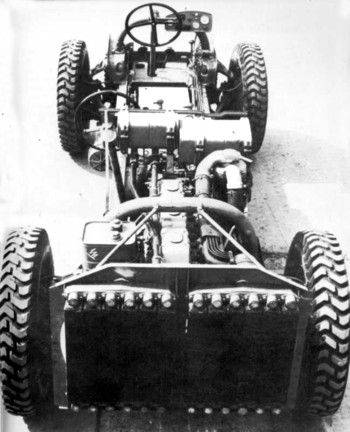
Chassis TM40, modified for use as the basis for the armored car AB.40. Photo by Warwheels.net
The AB.40 armored car was equipped with the SPA ABM1 petrol engine with 78 horsepower. The transmission, based on several original technical solutions, transmitted engine torque to all four wheels. An important feature of the five-speed gearbox was the ability to use all speeds as when moving forward, and when driving in reverse. It was assumed that such chassis capabilities would significantly increase the mobility of the armored car. The base chassis had independent suspension on all four wheels.
To improve the patency of the proposed use of spare wheels. They were transported on special mounts that allowed them to rotate, and also slightly protruded beyond the level of the bottom of the hull. Due to this, the car could lean on the obstacle with spare wheels, not “sitting” on the bottom.
The crew of the armored car AB.40 consisted of four people. The driver was in front of the hull and watched the road through the front access hatch with an armored cap. The second driver, who drove the car in reverse, was in the stern of the fighting compartment and had the entire set of controls. In the central part of the fighting compartment were the shooter and the commander.
The FIAT-Ansaldo Autoblindo armored vehicle of the first model was armed with three Breda Mod.38 machine guns of 8 mm caliber. Two machine guns were placed in a twin installation in a rotating turret. Thanks to this, the shooter could fire in any direction and fire at targets in a fairly wide vertical sector. The third machine gun was placed in the embrasure of the stern sheet of the fighting compartment.
The AB.40 had a total length of 5,2 m, a width of the order of 1,9 m and a height of 2,5 m. The combat weight of the armored car reached 7,5 t. Due to the relatively powerful engine, the new armored car on the highway could reach speeds of up to 78 km / h. When driving on rough terrain, the maximum speed dropped to 35-38 km / h. Fuel tanks provided a power reserve at 400 km.
Armored car AB first version was adopted in the 1940 year, which was reflected in its name. For several months, FIAT supplied the 24 base chassis, on the basis of which new armored cars were soon built. All this equipment was transferred to the customer and distributed among several units.
The main operator of the AB.40 machines was the colonial police operating in North Africa. The armored car with anti-bullet protection and machine-gun armament coped well with the assigned tasks, but soon the command decided that it was necessary to modernize this technology. The development of the updated project took some time, which is why the upgraded armored car went out for tests and was adopted only in the 1941 year. As a result, the new car was named AB.41.
During the modernization, the armored car retained all the main components and assemblies, but received a new engine and a different turret. In the engine compartment placed petrol engine SPA ABM2 power 88 hp Despite some change in the weight of the updated car, a more powerful engine allowed to maintain the driving performance at the same level.
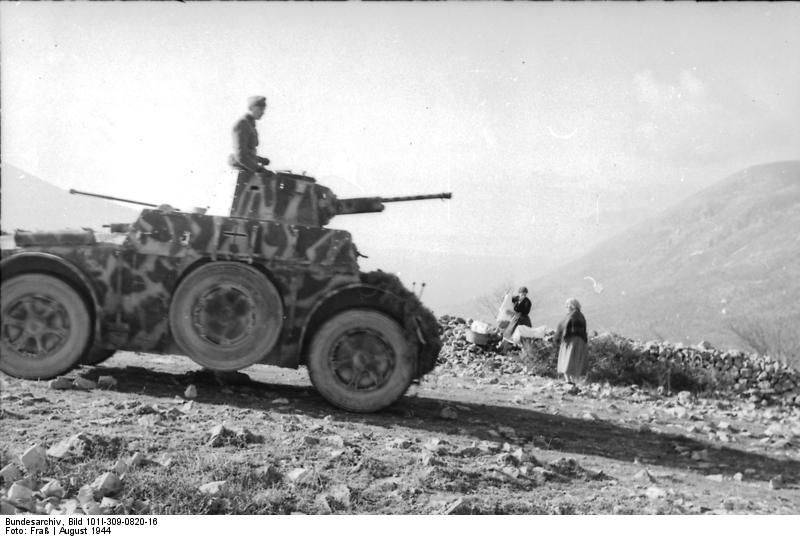
Armored AB.41 in North Africa. Photo of Wikimedia Commons
The first months of operation of the armored car AB.40 showed that the armament of three machine guns may not be enough to solve some problems. In addition, similar weapon did not fully meet the requirements of the military, who intended to use armored cars to support cavalry and infantry. Thus, in the requirements for the project AB.41 there was a clause on changing the composition of weapons.
To simplify the production of modernized armored cars, it was decided to use the existing tower. Instead of the native unit on the roof of the body, they suggested mounting a light tower tank FIAT L6 / 40 with appropriate weapons. After such a rearmament, the AB.41 armored car carried one Breda 20/65 Mod.35 automatic cannon of 20 mm caliber and an 8-mm Breda Mod.38 machine gun paired with it. The hull did not undergo major changes, because of which the stern machine gun remained in its place.
The upgraded armored car was put into service in the 1941 year and soon went into series. Unification with the existing light tank, as well as the successful combination of mobility, fire characteristics and other parameters allowed the AB.41 to become the most successful and massive representative of its family. The production of the Autoblindo model 1941 y. Lasted until the 1943 year. During this time, 600 machines were built, which were distributed between the cavalry and the colonial police.
During the operation, the gun armored cars of the new model have proven themselves well. The result was the emergence of plans to develop a new modification of the AB armored car with enhanced cannon armament. Work on the creation of new technology started in 1942 year, which was also reflected in the index of one of the projects
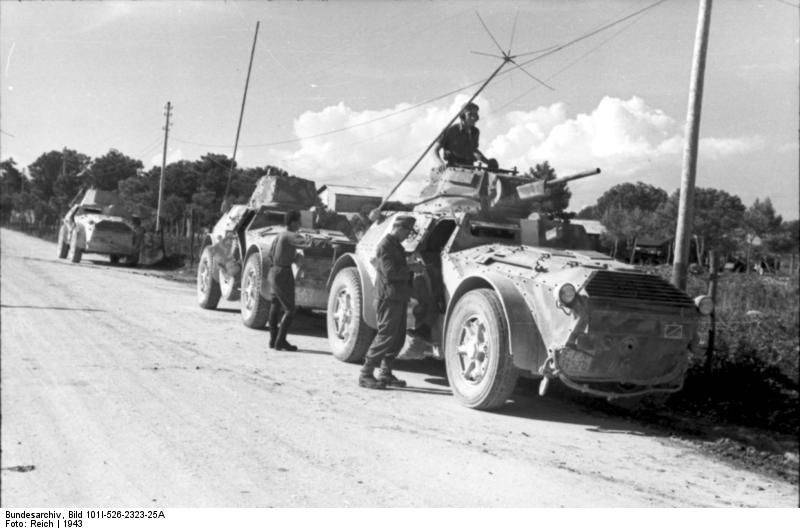
Armored AB.41 in the Balkans. Photo of Wikimedia Commons
Already in 1942, a project appeared, conventionally designated as AB.42. His main innovation was the updated combat compartment. Instead of the tower, it was proposed to mount an anti-tank gun with an installation for an anti-tank gun. To attack the enemy's armored vehicles, the new armored car was supposed to use the 47 / 32 Mod.35 gun of 47 mm. Inside the fighting compartment could be placed at least 60 shells for the gun. As an auxiliary weapon, a stern machine gun was maintained.
There is information about the construction and testing of the prototype armored AB.42 with 47-mm gun. However, he was the only machine of his type. The proposed project did not suit the military because of insufficient combat performance and insufficient protection of the crew. The result of the failure of the military was the emergence of a new project AB.43.
The armored car AB.43 received a turret, similar in design to the turret of a L6 / 40 tank or an AB.41 armored car. The upgraded turret housed the 47 / 25 Mod.35 cannon and the Breda machine gun 8-mm paired. On the stern sheet of the fighting compartment, as before, there was an embrasure for another machine gun. Inside the fighting compartment, we managed to place the 63 projectile cannons.
After installing a new tower with more powerful weapons, the estimated weight of the armored car approached the 8 t. To maintain acceptable performance, it was decided to equip the car with a new engine. This time used the motor of the SPA ABM family with the HP 108 power. Such a power plant has significantly increased the power density of the machine. In the armored car AB.43, this parameter reached the 13,5 HP. per ton of weight. For comparison, the power density of the AB.40 and AB.41 machines was 10,4 and 11,7 HP. per ton, respectively. However, the increase in performance was insignificant. The maximum speed on the highway increased only to 80 km / h, and the power reserve, on the contrary, decreased. At one gas station, a new gun armored car could pass no more than 350 km.
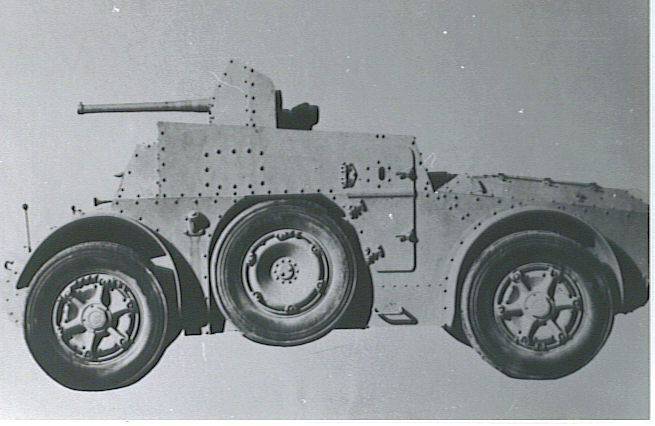
The prototype armored AB.42 with 47-mm gun. Photo of Wikimedia Commons
The first model of armored car AB.43 came to the test in May 1943. During the first tests, some problems were identified, which took several months to eliminate. Launching and testing delayed until August. Only at the end of the summer 1943-th new armored car was adopted. By this time, the company FIAT and Ansaldo managed to collect the first few serial machines.
In early September 1943, the Kingdom of Italy capitulated. Part of the armored cars in the ranks went to the troops of the anti-Hitler coalition. However, the construction of FIAT-Ansaldo Autoblindo did not stop. Nazi Germany, capturing the northern regions of Italy, restored the production of some types of equipment, including armored AB.43.
New cars of this type were built for various German structures and were designated as Panzerspähwagen (PzSpWg) AB.43 203 (I). German armored cars differed from the basic version with the PaK 38 tool of the 50 mm caliber, machine guns (MG34 or MG42), as well as some other units and assemblies. In particular, there is information about the construction of armored cars without a tower, equipped with an open wheelhouse with a weapon.
From August 1943 to the end of 1944, a total of AB.70 armored vehicles, including the German PzSpWg AB.43 43 (I), were manufactured up to 203. Only a few units of this technology managed to enter the army of Italy, all others were exploited by German troops.
Due to its large number (almost 700 units), armored cars of the FIAT-Ansaldo AB family managed to take part in battles on all fronts, where Italy was at war. At the same time, the results of using such a technique depended on a mass of factors, on the terrain, to the level of preparation and arming of the enemy. Thus, “establishing order” in Africa was carried out with quite a great success, and attempts to use armored cars in battles with a well-armed enemy often resulted in the loss of equipment.
The bulletproof reservation seriously limited the scope of use of AB machines of all models. In addition, in some cases, machine-gun or even cannon armament could not cope with the tasks assigned to it. As a result, the armored cars tried to keep away from the front and used in police operations, where they could show acceptable performance.
Some armored vehicles were involved in patrolling the railways. Part of this technology was equipped with a set of special equipment that turned an armored car into an armored rubber. In front of the car, a special bump was installed to remove obstacles from the rails, and the wheels with tires were replaced with rail. Such a revision allowed the armored car to travel directly along the railway tracks without any problems finding a suitable road along the guarded section.
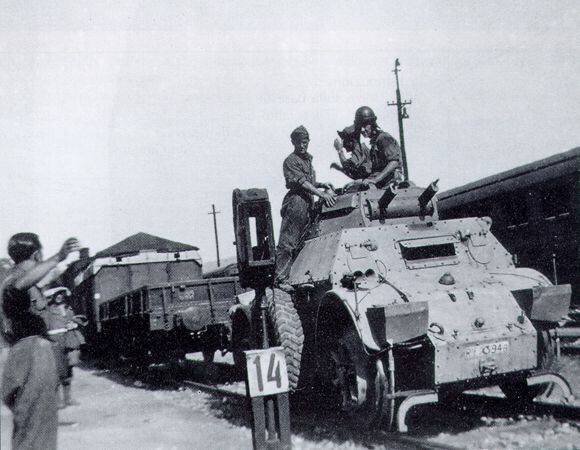
Armored car AB.40 in railway configuration
The AB.40, AB.41 and AB.43 armored vehicles were present in all the territories occupied by Italy, from Ethiopia to the Balkans. According to some reports, several vehicles of this family were used by Italian units that fought on the territory of the Soviet Union. Built after the fall of the 1943, the “German” vehicles were mainly used to patrol the rear and were not used in combat.
By the end of the war in Europe, the Italian FIAT-Ansaldo armored cars suffered serious losses. In direct collisions with the enemy during raids aviation and due to the actions of the partisans a large amount of such equipment was lost. The remaining cars eventually became trophies of the allies. The countries of the anti-Hitler coalition showed a certain interest in captured equipment and, as soon as possible, began to study it.
Almost all the armored cars that survived until the end of the war were transferred to the new Italian authorities, after which they were restored and returned to service. In the first post-war years, similar equipment was used in the armed forces and police structures. However, over time, all the armored cars of the AB family were written off after the resource was consumed.
The overwhelming majority of FIAT-Ansaldo Autoblindo armored vehicles were disposed of after a service life or due to damage that prevented repairs. Several of these machines have survived to our time and are now museum exhibits.
On the materials of the sites:
http://comandosupremo.com/
http://corazzati.it/
http://wwiivehicles.com/
http://militaryfactory.com/
http://warwheels.net/
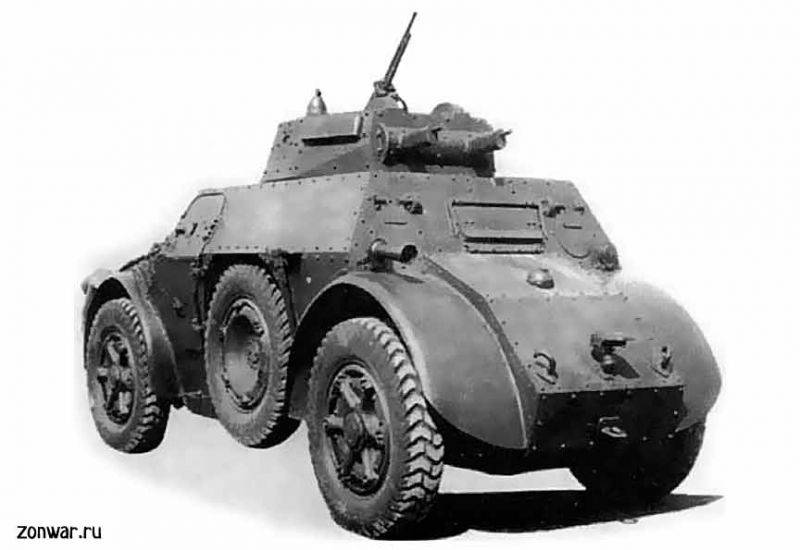
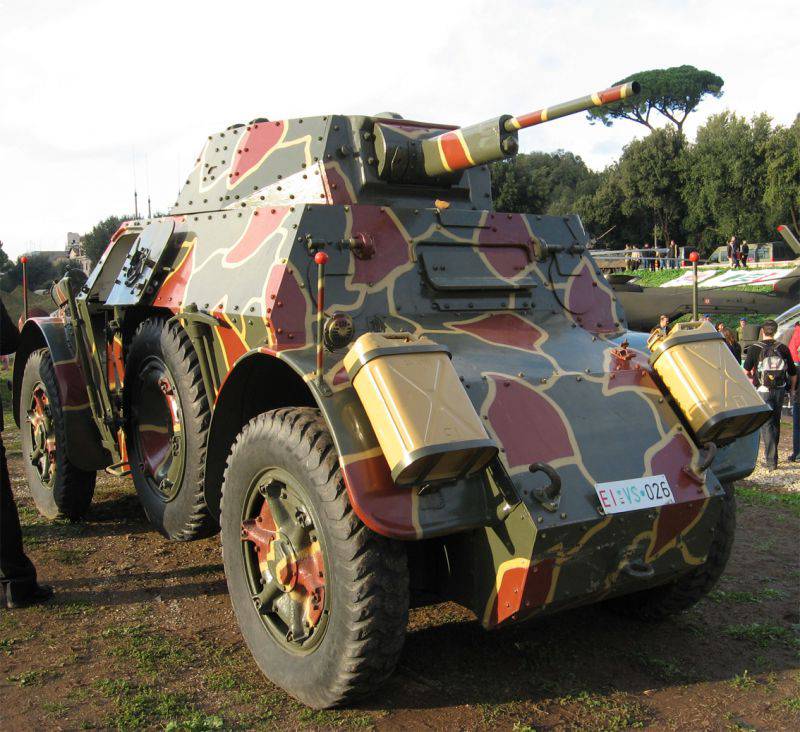
Information